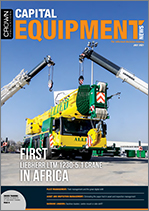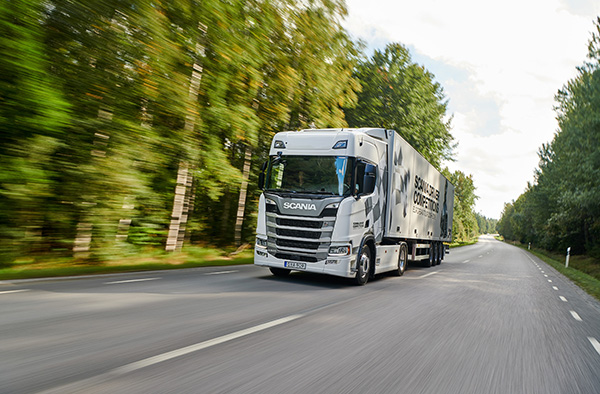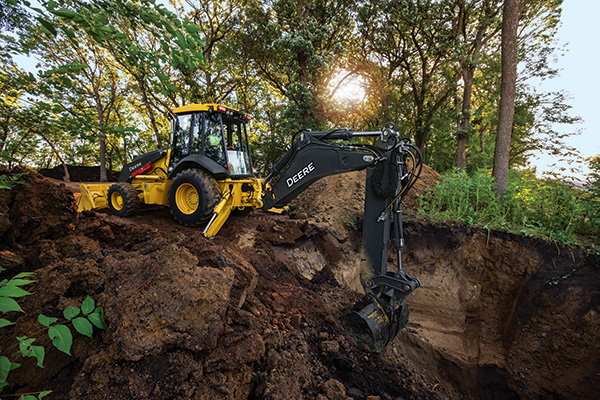 On the Cover: Allied Crane Hire has taken delivery of the first Liebherr LTM 1230-5.1 mobile crane in Africa. The five-axle crane scores with the longest boom in the 230 t class and a range of Liebherr’s technological advancements such as the single engine concept, VarrioBallast and VarioBase support technology – features that were central to the crane hire specialist’s buying decision.
On the Cover: Allied Crane Hire has taken delivery of the first Liebherr LTM 1230-5.1 mobile crane in Africa. The five-axle crane scores with the longest boom in the 230 t class and a range of Liebherr’s technological advancements such as the single engine concept, VarrioBallast and VarioBase support technology – features that were central to the crane hire specialist’s buying decision.
Headquartered in South Africa, Allied Crane Hire is an established name in the crane rental industry in Africa. Founded some 24 years ago, the company provides specialist crane hire services across sub-Saharan Africa with its fleet of over 80 mobile and crawler cranes. Key markets of focus include mining, petrochemical, wind and solar farms, as well as the construction industry.
Allied Crane Hire bought its first Liebherr Crane some 20 years ago, and never looked back. The latest addition to the company’s fleet is the Liebherr LTM 1230-5.1 mobile crane – the first of this model in Africa – which takes the company’s complement of Liebherr cranes to 14. GM André Engelbrecht (Jnr) tells Capital Equipment News that the company has another LTM 1230-5.1 on order, which is due to be delivered in April next year.
Engelbrecht is excited to be the first recipient of the LTM 1230-5.1 in Africa. Commenting on why the company opted for this specific model, he says, “We can’t look past the German technology. It is actually the best there is! Many in the crane sector will agree with me that Liebherr has the best tech in the mobile crane game and they keep on developing. That’s what mostly stands out for us.”
Reaping the benefits of OEM driver training
As commercial vehicle technology keeps progressing, fleet owners are putting their trust in OEM driver training programmes to keep their drivers up to date with the rapid pace of innovation. As a result, Scania Southern Africa has seen increased demand for its driver training services in recent years.

Although the training truck drivers initially received may have been sufficient for them to get a driver’s licence, it surely did not cover the issues fleet owners want them to know in order for them to drive for the organisation. A good training programme thus enhances them with the knowledge and skills to be safe and economic drivers. While this is crucial for all new drivers, training must not stop there; all truck drivers should be provided with ongoing driver education.
For many years the transport industry did not have many positive things to say about drivers and the driver did not receive much attention. It is, however, encouraging to see that this has changed over the years, reasons Johan Foley, Driver Training manager at Scania Southern Africa, and the vehicle fleet operator has now realised that the driver is an integral part of the transport company, its profitability and success.
“We believe that the driver should receive recognition as a valuable and professional employee of the organisation,” states Foley. “The driver is the employee who has the most inconvenienced task to do, although they use the most expensive tools to carry out their duties.”
The driver is the front line of any organisation, adds Foley, and the one employee who sees the company’s customers daily. They interact with customers more than any manager. The skills of the driver are, therefore, very important in maintaining the quality and level of service to the customer, and that is instrumental to the profitability of the organisation.
“The driver should have basic knowledge and an understanding of the mechanical aspects of a vehicle. This enables them to do valuable pre, post and on-route checks of the vehicle. This knowledge enables the driver to do defect reporting and to know if the defect was resolved as required,” explains Foley.
These actions, he adds, will ensure that the vehicles are available and reliable to provide a service that exceeds the expectation of the customer. “It is also important that the driver is knowledgeable about the loading capacities of the vehicle as they are responsible for ensuring the load arrives in a good condition at the customer,” he says.
Appointing the correct driver and applying regular training and development has several benefits for the transport operator. Firstly, a well-trained driver is fundamental to achieving reduced fuel consumption. “Fuel is such a high-priced commodity and the driver is an essential part in keeping the costs and usage low,” says Foley.
Secondly, he says, maintenance costs of the vehicle also depend on economical driving patterns. The more economically the driver applies their skills, the lower the maintenance expenses.
Driving behaviour also impacts tyre costs. Tyre costs, says Foley, can be reduced if the driver takes care and applies economical driving patterns. Additionally, good drivers result in satisfied customers as loads are delivered safely and on time.
“It is therefore important that organisations look at the welfare and wellbeing of the driver as they contribute a large percentage to the profitability to the organisation,” says Foley.
Backhoe loaders: centre-mount or side-shift?
The debate over centre mount versus side-shift backhoes is ongoing, with some in the industry preferring the superior lifting capacity of the former and others attracted to the greater lateral reach offered by the latter. This feature highlights the differences between the two, their applications, advantages and disadvantages, and sheds light on some of the models available in the market.

The primary difference between the centre mount (or centre pivot) and side-shift backhoe, according to of Mahindra South Africa CEO Rajesh Gupta, lies in the placement of the swing post.
“On a centre-mount backhoe, the swing post is mounted in the middle, at the centre of the H-frame while, on the side-shift version, the swing post can be moved to either side of centre, allowing the backhoe arm to move exactly as required by the operator.
He says the centre mount backhoe is suited to “a very specific operation” where the work is clearly defined and the area is well controlled.
“The side-shift backhoe, by contrast, is the backhoe of choice if the environment is bound to change and where the work is more demanding. Think, for instance, of working on hilly ground or doing corner trenching, where there is some difficulty to manoeuvre.”
Revaro Construction Operations manager Lourens Ackerman agrees, saying the central position of the swing post on centre mount backhoes is a fixed position from where the stabilisers swing out and down from the sides of the frame.
“A side-shift backhoe is designed with the backhoe’s kingpost mounted on a carrier. This carrier can slide from one side to the other along a frame, with rails that include stabilisers mounted on both sides, which extend vertically.”
He says the choice between using a centre mount or side-shift backhoe should be based on the nature of the project: “Consider the type of trench you plan to dig or the space constraints in which you will be doing the work.”
Griffiths Makgate, C&F sales manager Africa and Middle East at John Deere, adds that the stabilisers on centre mount machines “open wide and protrude beyond the width of the machine”.
“On side-shift machines, the backhoe moves sideways and the stabilisers are positioned vertically. Their width matches that of the machine.”








